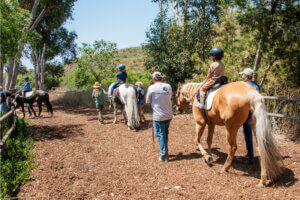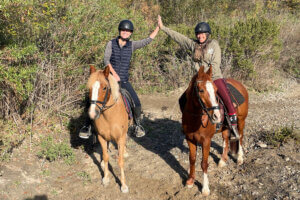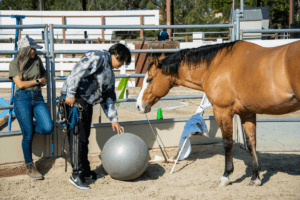
Saddle Fitting at The Shea Center
April 22, 2024
By Madison Miranda
Having the correct saddle fit is an essential part of horseback riding. The way the saddle is structured needs to accommodate both the horse and the rider, making it necessary to have various saddle types and sizes. The Shea Center has over six thousand combinations of tack from which to choose. Professional saddle fitter Damian Pichardo assesses the herd twice a year or as needed by fitting different saddle and pad combinations on each horse.
Damian recently came to assess the herd and educated staff on proper saddle fit. He has an impressive background in both performance and Roman riding and has been fitting saddles professionally for many years. When educating staff, Damian highlighted five main areas to consider: shoulder freedom, the wither area, the spine, the saddle support area, and billet placement. A common theme he has found when fitting saddles is that they can be “too narrow (in width) and too wide (in angle).”
“While a saddle may have a good fit initially, with natural changes over time, the saddle may need to be adjusted with supporting pads to fit better.”
To help ensure the comfort of our herd, saddle fit is a priority. Horses’ bodies can change depending on factors such as exercise and feed. Therefore, while a saddle may have a good fit initially, with natural changes over time, the saddle may need to be adjusted with supporting pads to fit better. These pad styles include thinline half pads with different shim options or foam risers.
Once each horse has a variety of saddles to choose from, The Shea Center therapists and instructors choose saddles based on each client’s needs. The Shea professional will look at the various qualities of the saddle, including the knee rolls, the front and back support of the pommel (front) and cantle (back), and the seat size. Therapists and instructors use many saddles, including western, dressage, all-purpose, jumping, and Australian hybrid saddles.

An example of the average western saddle that is often used in our programs, including Adaptive Riding and Military programs.

An example of the average English saddle that is often used in our programs. They sometimes have knee rolls or knee blocks inserted under the knee pad area to add stability for a rider or prevent the rider’s knee from moving forward during riding.







